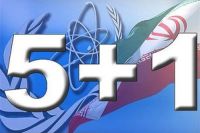 Perhaps, the ongoing developments in Iraq, which are characterized by rapid and yet suspicious advances of the Islamic State of Iraq and the Levant (ISIL) in northern parts of the country are meant to take the eyes of Iranians off developments in Ukraine and Syria.
Perhaps, the ongoing developments in Iraq, which are characterized by rapid and yet suspicious advances of the Islamic State of Iraq and the Levant (ISIL) in northern parts of the country are meant to take the eyes of Iranians off developments in Ukraine and Syria.
The daily surprises popping up in Brazil’s soccer World Cup have been able to do this job of distracting attentions, at least temporarily. However, it is certain that such events cannot divert the Iranians’ attention from nuclear negotiations.
The Iranian nuclear negotiating team is going ahead with intense negotiations with representatives of the six world powers, under the shadow of developments in Iraq and the World Cup. According to statements made by both negotiating sides, the main focus of the talks is on three major issues: “the two sides’ determination to remain committed to negotiations and, if needed, to extend the period of negotiations for a further six months;” “profound nature of differences;” and “hopes that the writing of a final comprehensive agreement between Iran and the P5+1 group will start during the ongoing talks.” These three issues prove that each side is well aware of the positions, expectations, as well as limitations of the other side.
Some analysts, who are familiar with the general course of international negotiations, have said that a “miracle” is needed to help the two sides bridge their differences and start writing the full and final text of a comprehensive agreement by July 20, 2014. For this reason, both sides are trying to woo public opinion at home and at international level, and both sides are saying a possible extension of negotiations for another six months is quite natural.
The question, now, is why reaching a comprehensive agreement seems to be so difficult for Iran and the 5+1 Group, so that, “only a miracle” can help them reach an agreement, with less than a month to go until the original July deadline. It seems that all the difficulties related to these negotiations stem from two determining issues, which are also of utmost importance to both sides. In fact, any “comprehensive agreement” will critically depend on these two issues.
A) Assets
Both sides, Iran and the P5+1 group, have entered this new round of negotiations on the strength of the assets they have garnered during the past years. Those assets, as viewed by each of the two sides, have two different dimensions of threat and opportunity. Therefore, each side’s assets can be used as a stick against the other side in the negotiations. On the other hand, the same assets have given enough power to each negotiating side as to enable them to insist on their positions and expectations.
One side’s asset i.e., the P5+1’s asset is “overarching and multilayer sanctions”, which the West has tried to portray as legitimate, rooted in the sanctions resolutions adopted by the United Nations Security Council against Iran.
However, mostly are politically motivated and imposed by the United States in line with its hostile attitude towards the independent states including the Islamic Republic of Iran. As a result, for many countries, these sanctions, are so binding that they are not able to easily avoid implementing them and not to comply with them. The countries imposing those sanctions now believe that the sanctions have already met original expectations and fulfilled the main goals for which they have been imposed. The P5+1 group seeks to make the most of the sanctions it has imposed on the Islamic Republic. These sanctions have already turned into a variable in the world’s trade and political equations and communications. Therefore, the P5+1 group is not ready to easily lose this asset and considers it as a major trump without having any plan to ignore its multiple uses.
On the opposite side, Iran has made many achievements and reached a point in its totally peaceful nuclear energy program as to create enough confidence among the opposite parties both at regional and international levels. In doing this, Iran has been able to make its negotiating parties take into account the Islamic Republic’s expectations and considerations if they want to convince Tehran not to go further with its nuclear energy program. They have also accepted that Iran has adequate tools at its disposal to weigh down on the negotiations. Iran is also not willing to easily lose its assets.
There is no doubt that none of these two negotiating sides will be ready to sacrifice its assets in order to gain the other sides’ optimism, trust, goodwill and determination.
B) Irreversibility or point of no return
The second issue, which can have a direct effect on the comprehensive agreement, is the issue of irreversibility or reaching the point of no return of the two sides’ assets after they manage to clinch a comprehensive agreement. Therefore, both sides should make sure that future political developments in those countries that are considered the main parties to the negotiations that is, Iran and the United States will do no harm to the comprehensive agreement and its goals.
Measures that should be taken by both sides in a comprehensive agreement should be pinpointed with an adequate degree of accuracy, surety and transparency. In this way, the two sides would be, firstly, able to forgo their assets gradually or all at once, pass over what they have earned in the past years, and reverse the situation on both sides, at least, to what it was before Iran's nuclear case was referred by the International Atomic Energy Agency (IAEA) to the UN Security Council.
Secondly, the two sides should be given sufficient, practical and powerful guarantees that the comprehensive agreement will be able to assure both sides and the international community, for at least one decade, that none of the negotiating sides will have the possibility nor the determination to go back to their current positions in terms of assets, at least, in a rapid way.
By the way, obtaining such guarantees can prove to be the most important impediment on the way of rapid and easy achievement of a comprehensive agreement.
If achieved, a comprehensive agreement between Iran and the P5+1 group can be considered as one of the most important and most influential disarmament agreements with great impact on regional and international equations reached during, at least, the past decade. Achieving such an agreement is sure to be met with special difficulties and calls on each side to be patient and have necessary determination to build trust with and assure the other side. It seems that despite all internal and external pressures on the main players in nuclear negotiations, such a determination actually exists among them. Iran has spared no efforts in this regard to build confidence with all international bodies, the International Atomic Energy Agency, IAEA in particular. Now the ball is on the court of the other side to come up with serious measures to help end the lengthy talks on already peaceful nuclear issue pursued by Tehran.
Tags: Comprehensive Agreement, Iran and P5+1, Islamic State of Iraq and the Levant (ISIL), Sanctions Resolutions, International Atomic Energy Agency (IAEA)

















